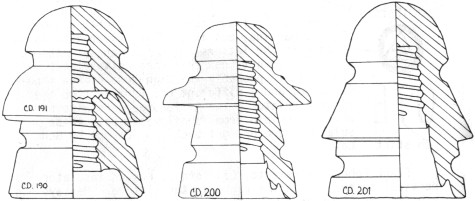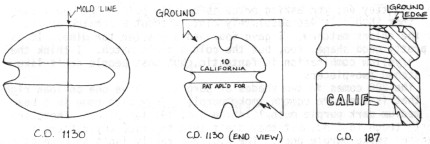the "California Connection"
by Brent Burger
Reprinted from "INSULATORS - Crown Jewels of the Wire", February 1981, page 6
TRAMPS. CALIFORNIA made three of these. We know them as the C.D.
190/191 TWO-PIECE, the C.D. 200, and the C.D. 201. Of the five or so CAL's that
are really rare, these three surely fit in. The TWO-PIECE is one of the rarest,
if not THE rarest. There are only about a dozen of these in collectors' hands
today. As far as I know, all were found in California, in the south central
coast area. I have one of these in my collection. So far, with mine included, I
have seen three of these, and so far, no two have matched in color.

The tops are
consistently a nice medium dark purple. This is very purple with no smoke. The
bases, on the other hand, have yet to even come close to each other. Mine is
yellow. A collector a few miles north of here has one with a base that is smoke
with little or no purple in it, And I got to peek at one that had just sold, and
its base was a nice purple that matched the top. These guys come embossed: on
both top and bottom. Every top I've seen has had weak embossing with the "A
021" barely discernable.

The bases have all had very bold, sharp
embossing. The "A 021" on these didn't fare so well as the
"CALIFORNIA", but it is quite plain. These guys, like the other tramps
and the sharp dripped C.D. 161, are tough to put a set value on. They just don't
sell that often, and when they do, the asking price is usually paid. The one I
saw sell took $600. It was absolutely mint, without a scratch on it, and the
colors matched. I gave four and a quarter for mine. It is in pretty good shape,
too, but the colors don't match. I think the purple/yellow combination is
fantastic, but most people don't like mismatched two-piecers.
The 200
comes in two shades of purple. I have one on loan right now that is the more
common smoke-purple. They also come in a beautiful medium dark purple much like
the C.D. 191 top piece. These are pretty tough to find, but they don't seem to
price any differently than the smoke-purple ones. The C.D. 200 really isn't as
rare as one might think. They are probably the most desirable CALIFORNIA and are
sought by CALIFORNIA specialists and "general" collectors alike. For
this reason, the 200 doesn't last long on sales tables. They generally price in
the $200-$250 category. I saw one of the dark ones go for $165!
There are about
75 200's around these days. Most were found in the Los Angeles area and southern
San Joaquin Valley. They have been found scattered here and there up the coast
all the way to the border. Someone lucked out and brought a bunch down off the
top of a building in Tacoma, Washington. I think they found five or ten of them.
Poor soul.
The 201 is a super rare one. Thirteen of them have been found. Most
of those were found in the L.A., Watts area. As far as I know, they only come in
one color, aqua. It is a greenish aqua that really isn't anything spectacular in
itself. The only thing that makes this thing desirable is the CALIFORNIA
embossing on the small flat skirt area between the lower wire-groove and the
base. This area is extremely thin. I wouldn't be surprised if a lot of these
were found with no lower skirt section. I gave $250 for mine. It has two chips
of thumbnail size, one on the skirt, and another directly above it on the
umbrella that removed a bit of glass. The only other one I know the price paid
for, took four hundred dollars. It also had two thumb-nailers on it, both on the
umbrella. They didn't take near as much glass with them as mine did. I would
think $500 would be about right for a good mint one.
CALIFORNIA made some
oddballs that they didn't make a whole variety of (like their signals) that
don't really fit into a category such as "signals" or
"communications". Utilizing great creativity and imagination, I call
this group "the oddballs"! Under this heading fall the C.D. 187
"THRU-HOLE" and the C.D. 1130 "EGGs".
The CALIFORNIA C.D.
187 has never struck me as being a very pretty insulator. Their color is always
dingy and washed-out, so they never have much "show". I have only one
of these. It is smoky-clear. I've seen smoke-yellow, smoke-purple, smoke, and
one that had the purple standing out pretty well from the smoke in it.
CALIFORNIA is boldly embossed on the flat skirt section. This embossing is
upright, so when this insulator was used as it was designed to be, the embossing
was upside-down. The folks at the CALIFORNIA plant took these to the grinder
after cooling. They were made in a break away mold which left nice sharp edges
on the top. All the C.D. 187's I have seen have this top ground off. The one in
my collection also had the mold line along the base ground off. I gave $18 for
mine. Most others I have seen had $25 price tags on them.

There have been
two styles, or sizes, of CALIFORNIA "egg" found -- the number 10 and the
larger number 15. It was rumored a few years back that a number 20 egg was found
near the coast in southern California. I never heard anything more about it,
though. I would imagine if a number 20 "egg" were produced, it would
be even larger than the number 15 "large egg". Does anybody know
anything about this one? I am certainly eager to hear it if there is a story
behind it!
The number 10 and 15 come embossed basically the same way (see
sketch), the difference being, of course, the number. Number 15's carry their
number in the same place as the number 10's. I have noticed a lot of difference
in embossings within each size number. The apostrophe in "APL'D" on
the number 15's leans way forward, or curves backward, or sits straight up and
down; and the letter spacing is different on almost every one I have seen. Some
come with wide spaced words and letters, and others come all cramped up at one
end like they ran out of space. It will be a while before I have a whole bunch
of these and can really sit down and figure out what they did here.
The number
ten "egg" comes with plenty of variation, too. There are two definite
embossing variations here that are worthy of note. The number 10 "small
egg" comes with an embossing error, and the other variation comes with the
correct embossing. The error is with the word "PAT", where someone
forgot to cross the "T", so you get ''PAl APL'D FOR". I have the
correctly embossed variation which is a little scarcer. CALIFORNIA number 10
"eggs" are found only in light green. Not really a sage green, either,
just a plain (sagy, if you will) light green. The number 15 "large
egg" comes in both this light green and smoke-purple.
Number 10
"eggs", although one of the rarer CALIFORNIAS, have come way down in
value. Where they were once selling for $200, they now go for half of that. I
paid $130 for mine and have passed up several others for $100 that were in super
condition. Number 15 "eggs", not being quite as scarce as the
"small egg", do not command such a high price. These usually sell for
between seventy-five and one hundred dollars when in mint condition and of the
purple coloration. The green ones go for slightly less.
CALIFORNIA made their
strain-"eggs" in a two piece split mold (see sketch for mold line).
Because of this molding process, the insulators are left with a large glass
button on them where the glass was not fully forced into the mold and cooled in
the injection tube. This "button" was usually ground off after
cooling, leaving a nice ground area about the size of a nickel on the insulator.
Every "small (#10) egg" that I have seen had the ground spot on the
upper left quarter when looking at the insulator from the embossing side (see
sketch). Number 15, "large eggs", have them on the upper left and
lower right quarters when looking at them from this angle. This
"button" was formed in a round shape with one half of the circle on
each side of the mold line. This was in accordance with the molding process,
where if it were formed anywhere but right on the mold line, the mold would be
inoperable, or the insulator would be damaged by the separating of the two mold
halves.
CALIFORNIA didn't do a very good job of making perfect specimens
when they made these. I don't think I have ever seen one in either size that was
nicely rounded or even close to symmetric. They lie over on their side, or one
of the quarters was not fully formed because not enough glass was forced into
the mold while it was still hot. Because of this, there is little or no shape
consistency amongst these units. They all seem to have their own unique little
shape that roughly follows what the mold maker was striving for when he made the
mold. Both the large and small "egg" have the same basic shape, so I
gave only one sketch. The difference is just in size. The small "egg"
is approximately (IT VARIES!) 3" long by 2-1/4" high at the widest
point. The large "egg" measures about 3-7/16" long by
2-7/16" high at the widest point. It would be a trick to give exact
measurements on these because they are always so misshapen.
12 to 15 number 10
"eggs" were found in the Los Angeles and San Francisco areas. Marvin
Collins reports that three were also found in Eureka, California. "These
were used on the long gone electric street car lines, and all three had the
embossing error." That brings a grand total of between 15 and 18 of these
guys in collectors' hands. I would think in such small numbers the small
"eggs" would be worth much more. So much for my understanding of
economics!
Quite a few of the number 15 "eggs" have been found, mostly
in the Los Angeles area and the southern San Joaquin Valley. As for exact
numbers on these, I really don't know. I would like to find out the exact
numbers on all the rarities just to get an idea of what is out there. If you've
got the time, why not drop me a line and tell me what you have?
I would like to
express a big thanks to Orval Smith, Chuck Henry, and Marvin Collins for
supplying information for this article. Without getting together and helping out
this hobby would go nowhere.
| 